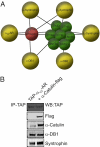Alpha-dystrobrevin-1 recruits alpha-catulin to the alpha1D-adrenergic receptor/dystrophin-associated protein complex signalosome
- PMID: 21115837
- PMCID: PMC3003112
- DOI: 10.1073/pnas.1010819107
Alpha-dystrobrevin-1 recruits alpha-catulin to the alpha1D-adrenergic receptor/dystrophin-associated protein complex signalosome
Abstract
α(1D)-Adrenergic receptors (ARs) are key regulators of cardiovascular system function that increase blood pressure and promote vascular remodeling. Unfortunately, little information exists about the signaling pathways used by this important G protein-coupled receptor (GPCR). We recently discovered that α(1D)-ARs form a "signalosome" with multiple members of the dystrophin-associated protein complex (DAPC) to become functionally expressed at the plasma membrane and bind ligands. However, the molecular mechanism by which the DAPC imparts functionality to the α(1D)-AR signalosome remains a mystery. To test the hypothesis that previously unidentified molecules are recruited to the α(1D)-AR signalosome, we performed an extensive proteomic analysis on each member of the DAPC. Bioinformatic analysis of our proteomic data sets detected a common interacting protein of relatively unknown function, α-catulin. Coimmunoprecipitation and blot overlay assays indicate that α-catulin is directly recruited to the α(1D)-AR signalosome by the C-terminal domain of α-dystrobrevin-1 and not the closely related splice variant α-dystrobrevin-2. Proteomic and biochemical analysis revealed that α-catulin supersensitizes α(1D)-AR functional responses by recruiting effector molecules to the signalosome. Taken together, our study implicates α-catulin as a unique regulator of GPCR signaling and represents a unique expansion of the intricate and continually evolving array of GPCR signaling networks.
Conflict of interest statement
The authors declare no conflict of interest.
Figures




References
-
- Hall RA, Lefkowitz RJ. Regulation of G protein-coupled receptor signaling by scaffold proteins. Circ Res. 2002;91:672–680. - PubMed
-
- Chen Z, Hague C, Hall RA, Minneman KP. Syntrophins regulate alpha1D-adrenergic receptors through a PDZ domain-mediated interaction. J Biol Chem. 2006;281:12414–12420. - PubMed
Publication types
MeSH terms
Substances
Grants and funding
- DA025182/DA/NIDA NIH HHS/United States
- T42 HD07453/HD/NICHD NIH HHS/United States
- R37 DA011672/DA/NIDA NIH HHS/United States
- R00 DA025182/DA/NIDA NIH HHS/United States
- HL088366/HL/NHLBI NIH HHS/United States
- K99 DA025182/DA/NIDA NIH HHS/United States
- T32 GM007270/GM/NIGMS NIH HHS/United States
- NS33145/NS/NINDS NIH HHS/United States
- T32 HD007453/HD/NICHD NIH HHS/United States
- T32 GM07270/GM/NIGMS NIH HHS/United States
- K05 DA020570/DA/NIDA NIH HHS/United States
- R01 NS033145/NS/NINDS NIH HHS/United States
- R01 HL088366/HL/NHLBI NIH HHS/United States
LinkOut - more resources
Full Text Sources
Other Literature Sources
Molecular Biology Databases
Research Materials

